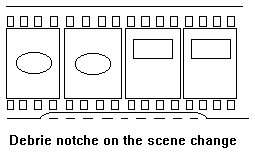Notches.
A widely used cueing system was provided by a notch cut into the edge of the film. The notch varied in length, from a frame to several frames, depending on the different manufacturer's system, was about 3mm deep, and did not reach the perforations. In this method, the grader makes a notch on the edge of the original at the point when a light change is required, or, in some systems a fixed number of frames before or after the scene change.
The notch activates the light change mechanism on the printer usually by the action of a lightly sprung roller running on the edge of the film attached to a micro-switch. A disadvantage of this method is that the original film is cut on the edge and in some ways damages or weakens the film. This method cannot be used when there are damaged perforations in the original and has its greatest benefit when a negative is being reprinted on the same type of printer that was used originally and the notches are already in place. The two major systems were devised by Debrie in France and Bell and Howell in the USA, but other notch systems, quite obviously based on these, were used for locally made printers in England, India, the old USSR, and almost certainly elsewhere. The difference between the Debrie method and the Bell and Howell method consists only in a different placement of the notches. The Debrie notches are placed on the scene change and the B & H notches are placed six frames after the scene change in 35 mm.
Some printing machines are adapted for the two methods. The Debrie position is the weakest as it positioned over the splice on a joined negative, and where this is found great care is needed to see that there are no edges to the splice that are standing out. The Bell and Howell notch presents no problems on other printers provided it is undamaged.
